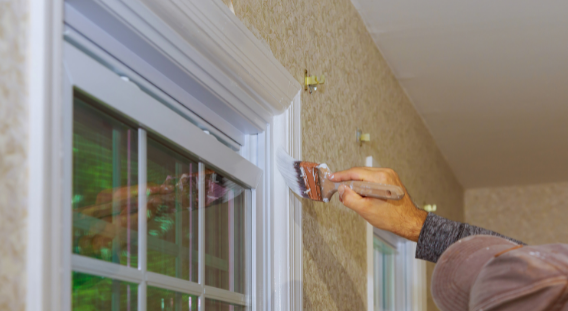
Why Should You Use Enamel Paint For Your Trim?
Posted on April 1, 2022
Have you ever wondered why trim and doors seem shinier than the walls and ceilings? In some cases, it’s because the painter used enamel paint. Enamel paints are made from petroleum products, making them oil-based paint. Oil-based paints are very durable and commonly used on outdoor projects like concrete and cast iron. Enamel paints are still commonly used by some painters for doors, windows, and trim due to their durability. Today we will discuss why enamels are used for areas you come into contact with, like trim.
What Is Enamel Paint?
Oil-based enamel paint uses the medium of oil and pigments to form a paint that is durable and long-lasting. Enamel paint was really the first commercially available paint and was commonly used to protect the exterior of buildings from water damage from the nineteenth century onward. Enamel paint, however, does produce VOCs, also known as volatile organic compounds.
These VOCs can be thought of as the fumes produced from the application of the paint. Breathing these fumes for extended periods can cause health problems, so oil-based enamels should not be used in an enclosed space with poor ventilation. The nature of enamel paint also requires a solvent to be used for cleaning, which is usually paint thinner, turpentine, or mineral spirits.
Is Enamel Paint Dangerous?
Enamel paints can be dangerous (when compared to latex) in certain situations, so caution is advised. Because enamel paint is oil-based, the solvent used for thinning and cleaning will likely be highly flammable. The VOCs mentioned earlier are also flammable, so great care should be taken when using enamels around any source of flame.
Why Is Enamel Paint Great For Trim?
Enamel paint dries to a very hard finish, making it durable and long-lasting. This is why it is seen in areas of the home prone to dirt and scuffs, like a doorway. Baseboards, door and window casing, crown molding, pass-through doorways, and arches are commonly painted with enamels due to their proximity to contact.
Professionals will usually use enamel paints outdoors, where ventilation is abundant to avoid the accumulation of VOCs. Enamels usually take considerably longer to dry than latex versions, so it’s a good idea to use enamels when the weather is warm and dry. After the surfaces are completely cured (often a couple of days) the trim can be brought in and installed.
As mentioned, door and window trim (as well as exterior doors) are often painted with enamel paint. However, some enamels can be very viscous and thick, which may leave brush and roller marks in the paint. The professionals will often use a small 4” to 6” foam roller instead of a brush or nap roller. Especially on metal doors, this method produces a much smoother finish.





